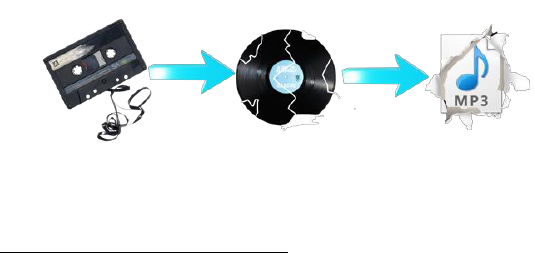
518
Volume 63 – Number 3
SMART ROYALTIES: TACKLING THE
MUSIC INDUSTRY’S COPYRIGHT DATA
DISCREPANCIES THROUGH BLOCKCHAIN
TECHNOLOGY, SMART CONTRACTS, AND
NON-FUNGIBLE TOKENS
AMANDA J. SHARP
*†
AND ORLY LOBEL
**
*
J.D. Candidate May 2023, Warren Family Scholarship
Recipient, C. Hugh Friedman Scholarship Recipient, University of San
Diego School of Law; 2021 San Diego County Bar Association
Diversity Fellow; 2023 Entertainment Law Initiative Writing
Competition Runner-Up; 2023 3L Next Gen California ChangeLawyer
Scholar. Thank you to the IDEA Law Review and its members,
specifically Lea Polito, Stephanie Casino, Matthew Arsenault,
Emmeline Drake, Mitchell Gross, Andrea Pelloquin, Andrew
Dominick, and Brittany Reeves for their contributions.
†
IDEA Vol. 63 thanks Amanda Sharp for participating in
IDEA’s Fall 2022 Symposium “IP in the Metaverse: Protecting IP
Rights in the Virtual World.”
**
University Professor, Warren Distinguished Professor of
Law, and Director of the Center for Employment and Labor Policy
(CELP), University of San Diego School of Law.
Smart Royalties: Tackling the Music Industry's Copyright
Data Discrepancies through Blockchain Technology,
Smart Contracts, and Non-Fungible Tokens 519
Volume 63 – Number 3
ABSTRACT
Blockchain technology, smart contracts, and non-
fungible tokens (“NFTs”) can create faster, more
transparent royalty regulation and distribution for music
creators while improving the initiatives set forth in the
Music Modernization Act of 2018 (the “MMA”). No one
likes a broken record, but the music industry’s system for
royalty collection and distribution has been disjunct,
inefficient, and incomplete since the digitization of CDs
into MP3 files in the 1990s. There have only been
retroactive fixes to treat the symptoms of a broken system
with no proactive solutions to identify the cause of the
underlying issues and eradicate them. This article analyzes
the incomplete history of digitizing musical metadata and
highlights how vital comprehensive royalty regulation is to
creators by considering the ramifications unmatched and
unclaimed works have on these individuals. The article
proposes three initiatives to address the inconsistent
metadata standard currently disrupting digital music
consumption: (1) the creation of an MMA-specific
blockchain that provides uniform, transparent data
standards; (2) the implementation of smart contracts to
facilitate autonomous royalty distribution; and (3) the
utilization of NFTs to connect smart contract functionality
with blockchain’s uniformity.
I. Introduction ............................................................. 520
II. A [Tuning] Fork in the Road: Copyright Law, Music
Ownership, and Royalty Regulation ............................... 526
A. Musical Copyrights—Musical Composition and
Sound Recording ......................................................... 526
B. Music Industry Entity Breakdown ...................... 530
520 IDEA The Law Review of the Franklin Pierce Center for IP
63 IDEA 518 (2023)
III. Addressing the Music Industry’s Biggest Broken
[Data] Record: Inconsistent Music Metadata Standards and
Lack of Comprehensive Database .................................. 532
A. Musical Mediums—Records to CDs to MP3s .... 532
B. Broken [Metadata] Records and Copyright
Ownership ................................................................... 536
IV. An Unmatched Solution to the Music Industry’s
Unmatched Royalty Problem: How Blockchain, Smart
Contracts, and NFTs can Revolutionize Royalty Regulation
and Distribution .............................................................. 538
A. A Universal Database with a Uniform Standard—
The MLC Blockchain ................................................. 538
B. Consistent, Automatic Royalty Distribution—Smart
Contracts ..................................................................... 547
C. Music Mediums Revisited—CDs to MP3s to
NFTs ........................................................................... 549
V. Conclusion .............................................................. 552
I. INTRODUCTION
A customer enters a bakery and orders a chocolate
chip cookie. The customer eats the cookie and then tells
the baker they will pay for the cookie . . . in six months.
The discrepancy here, between when the customer eats the
cookie and when the baker is paid, is objectively
unacceptable. Society would never let this type of behavior
go unadmonished. However, if two substitutes are made to
this example—a musical composition replaces the cookie,
and a songwriter replaces the baker—the crippling
implications of prolonged music royalty distribution on a
songwriter’s career become evident.

Smart Royalties: Tackling the Music Industry's Copyright
Data Discrepancies through Blockchain Technology,
Smart Contracts, and Non-Fungible Tokens 521
Volume 63 – Number 3
The most important component of the music
industry has always been creators. Songwriters create
recipes that record labels use to create wonderful dishes
that an unlimited number of people can sample. These
individuals rely on accurate data transfer—how frequently
a song has been played—to receive proper royalty
compensation. However, each entity involved in today’s
music royalty distribution process stores song data
differently. These database discrepancies create
incomplete, inconsistent data entries that result in lost
wages, data duplication, and unmatched or unclaimed
works.
1
Inaccurate data not only leads to songwriters not
getting paid but also to songwriters not receiving credit and
recognition for their talents. In an industry founded on
creative collaborations and networking, not giving credit to
the proper individuals can have a devastating impact on a
creator’s career.
2
New leaps in technology, like smart contracts and
non-fungible tokens (“NFTs”) housed on blockchains, can
make the music royalty distribution process more
transparent and the data collection governing music
copyright ownership more reliable and immune to
manipulation and delays.
3
Royalty allocation is dependent
1
Unclaimed works refer to inadequate information regarding
the writer’s and the publisher’s shares in a composition. See U.S.
COPYRIGHT OFF., UNCLAIMED ROYALTIES: BEST PRACTICES FOR THE
MECHANICAL LICENSING COLLECTIVE 43 (2021), https://www.copy
right.gov/policy/unclaimed-royalties/unclaimed-royalties-final-report.p
df [https://perma.cc/9THL-NU4R]. Thus, every time a master
recording is played, the songwriters and publisher will not receive
compensation. See Frequently Asked Questions, THE MLC,
https://www.themlc.com/faqs/categories/mlc [https://perma.cc/7B2Q-
Y3GQ] (last visited Mar. 23, 2023). Unmatched recordings implicate
the recording artist and record label. See id.
2
Catherine L. Fisk, Credit Where It’s Due: The Law and
Norms of Attribution, 95 GEO. L.J. 49, 76 (2006).
3
See infra Section IV (discussing NFTs and smart contracts).

522 IDEA The Law Review of the Franklin Pierce Center for IP
63 IDEA 518 (2023)
on accurate information being available, but the current
system lacks a uniform data standard, resulting in a slow,
and at times incomplete, compensation process.
4
Congress attempted to address these issues by
enacting the Music Modernization Act of 2018 (the
“MMA”).
5
The MMA offered a more efficient way for
streaming services to pay for music rights by creating a
blanket mechanical license that granted specific, limited
protections to streaming services playing full catalogs of
music provided by distributors and record labels.
6
In July
2019, the U.S. Register of Copyrights designated the
Mechanical Licensing Collective (the “MLC”) to simplify
the mechanical royalty regulation process and make
copyright ownership data more transparent.
7
A Board of
Directors—comprised of ten music publishers and four
professional songwriters—make up the MLC governance
structure.
8
Three Advisory Committees (the
4
See Leticia Trandafir, Everything Musicians Need to Know
about Music Distribution, LANDR BLOG (Jan. 12, 2021),
https://blog.landr.com/everything-musicians-need-know-digital-music-
distribution/ [https://perma.cc/22Y2-T84Q] (providing an in-depth
discussion on the music creation and distribution process); see also
infra note 21.
5
Orrin G. Hatch-Bob Goodlatte Music Modernization Act of
2018, Pub. L. No. 115-264, 132 Stat. 3676 (2018) (codified as amended
at 17 U.S.C. § 101).
6
Governance and Bylaws, THE MLC,
https://www.themlc.com/governance [https://perma.cc/9L73-EB42]
(last visited Mar. 23, 2023); see also Frequently Asked Questions,
supra note 1.
7
See Frequently Asked Questions, supra note 1.
8
Governance and Bylaws, supra note 6 (“[The MLC] is led by
a Board of Directors that is comprised of fourteen individuals: ten must
be representatives of music publishers and four must be professional
songwriters who retain and license mechanical rights for songs they
have written. No two Directors may be affiliated with music publishers
under common control or ownership. There are also three nonvoting
Directors representing trade organizations for songwriters, music
publishers, and digital music providers, respectively.”).

Smart Royalties: Tackling the Music Industry's Copyright
Data Discrepancies through Blockchain Technology,
Smart Contracts, and Non-Fungible Tokens 523
Volume 63 – Number 3
“Committees”) aid the MLC’s Board of Directors in
executing its objectives: the Unclaimed Royalties Oversight
Committee,
9
the Dispute Resolution Committee,
10
and the
Operations Advisory Committee.
11
These Committees help
serve the MLC’s “purposes, operations, or other activities
or topics,” but their exact roles are not clearly defined in
the current MLC bylaws.
12
When the MLC became the
exclusive administrator of the MMA’s blanket license
program, it was tasked with collecting royalties owed by
the streaming services and distributing those royalties to the
correct rightsholders.
13
The MLC also created a public database of musical
works, sound recordings, and copyright owners, hoping to
fix a system that had generated $2.5 billion in unclaimed
royalties by making copyright ownership information more
transparent and accessible to the public.
14
However, after
9
This committee is composed of five songwriters and five
music publishing representatives. Id.
10
This committee is composed of five songwriters and five
music publishing representatives. Id.
11
This committee is composed of six music publishing
representatives and six digital music provider representatives. Id.
12
See THE MLC, BYLAWS OF THE MECHANICAL LICENSING
COLLECTIVE 13 (2020), https://f.hubspotusercontent40.net/hubfs/871
8396/files/2020-05/Bylaws%20of%20The%20MLC.pdf [https://perma
.cc/SW7W-98YY].
13
A blanket license is issued by a collection society allowing a
user to play and/or perform all compositions or recordings managed by
all publishers represented by that group. Blanket License, SONGTRUST,
https://www.songtrust.com/music-publishing-glossary/glossary-blanket
-license [https://perma.cc/Q6XW-LQBC] (last visited Mar. 23, 2023);
THE MLC, 2021 ANNUAL REPORT 1 (2021), https://www.themlc.
com/hubfs/Marketing/23856%20The%20MLC%20AR2021%206-30%
20REFRESH%20COMBINED.pdf [https://perma.cc/BS5B-7DK4].
14
R.B. Jefferson, What Do the MMA and MLC mean for
Songwriters and Composers in 2021?, LAWYERS ROCK (Dec. 18,
2020), https://www.lawyersrock.com/what-do-the-mma-and-mlc-mean-
for-songwriters-and-composers- in-2021/ [https://perma.cc/X3CY-

524 IDEA The Law Review of the Franklin Pierce Center for IP
63 IDEA 518 (2023)
the MLC distributed its first round of royalty payments in
2021, nearly half a billion dollars of unmatched royalties
remained.
15
While the MLC was a positive step toward
reliable digitization of the music royalty system, significant
gaps in accomplishing a cohesive data tracking protocol
remain. The MLC created a system to identify some
unclaimed works and regulate mechanical royalty
distribution, yet it failed to provide a proactive solution that
can minimize future unmatched works and does not address
the three other types of music royalties at all.
16
The MLC’s initiatives are an important step, but
they are not the solution that will get the industry to a
comprehensive music royalty distribution finish line.
Hundreds of millions of dollars in unmatched royalties are
still held by the MLC, and the number is set to grow as the
process of matching royalties to artists remains slow and
arduous.
17
Blockchain technology, smart contracts, and
NFTs can be implemented to streamline the music royalty
distribution system. Smart contracts would track copyright
RZF9]. The MLC also implemented a system called SoundExchange
to track satellite and digital radio logs. Id. SoundExchange is a state-
of-the-art music fingerprinting technology that records radio broadcasts
and then cross-checks those streams with a database of 68 million
songs to record public performance royalties. Who We Are,
SOUNDEXCHANGE, https://www.soundexchange.com/who-we-are/ [htt
ps://perma.cc/XN87-9UTX] (last visited Dec. 13, 2022).
15
The exact value of unmatched royalties remaining is
$424,384,787. LB Cantrell, The MLC Receives $424 Million In
Historical Unmatched Royalties From DSPs, MUSICROW (Feb. 16,
2021), https://musicrow.com/2021/02/the-mlc-receives-424-million-in-
historical-unmatched-royalties-from-dsps/ [https://perma.cc/FY59-ZW
CE]; see infra notes 41–46 and accompanying text (discussing the
cause of accrued historical unmatched royalties).
16
See infra note 21 (discussing public performance royalties,
synchronization royalties, and print music royalties).
17
In the current system, a creator must wait months to receive
compensation. See infra Section II(B) (providing additional
information regarding the specific entities involved in this process).

Smart Royalties: Tackling the Music Industry's Copyright
Data Discrepancies through Blockchain Technology,
Smart Contracts, and Non-Fungible Tokens 525
Volume 63 – Number 3
ownership information while NFTs would store song
metadata, and both would be recorded and tracked on an
MLC-specific blockchain. Utilizing these innovative
methods, in conjunction with the MLC’s current initiatives,
would accomplish autonomous, transparent, and
instantaneous royalty distribution.
Section II of this article establishes the two types of
musical copyrights—musical compositions and sound
recordings—and silos the music industry’s entities into
three categories: music-creation entities, business
intermediaries, and customer-facing entities. Section III
explores the history of music royalty regulation and
identifies the main issue keeping the current system from
functioning efficiently: inconsistent metadata tracking and
lack of a uniform database to house accurate data. Section
IV proposes a solution to this problem: an MLC-operated
blockchain that employs NFTs (tracking song metadata)
and smart contracts (tracking copyright ownership splits) to
facilitate smart royalty distributions. Finally, Section V
summarizes the benefits of the proposed solutions and
argues that utilizing blockchain technology, smart
contracts, and NFTs would fulfil the MLC’s purpose to
simplify the royalty regulation process and make copyright
ownership transparent for all users.
18
18
The Mechanical Licensing Collective (MLC), COPYRIGHT
ALLIANCE, https://copyrightalliance.org/trending-topics/mechanical-lic
ensing-collective/ [https://perma.cc/D7QW-CFN9] (last visited Mar.
23, 2023) (“The MLC’s mission is to ensure that songwriters,
composers, lyricists, and music publishers receive accurate and timely
mechanical license royalty payments from streaming and download
services across the U.S. To fulfill this goal, the MLC built a publicly
accessible musical works database, along with a portal that creators and
music publishers can use to submit and maintain their musical works
data. It also developed a number of other related tools to ensure that
the process of registering with the MLC (and tracking royalties through
it) is a smooth and seamless process.”).

526 IDEA The Law Review of the Franklin Pierce Center for IP
63 IDEA 518 (2023)
II. A [TUNING] FORK IN THE ROAD: COPYRIGHT
LAW, MUSIC OWNERSHIP, AND ROYALTY
REGULATION
A. Musical Copyrights—Musical Composition
and Sound Recording
Every song has two copyrightable layers—a
musical composition and a sound recording.
19
Musical
compositions are the totality of underlying notes, lyrics,
and melody that make up a song.
20
Musical compositions
create publishing rights that result in public performance
royalties paid to the creator and their publisher.
21
A sound
19
U.S. COPYRIGHT OFF., COMPENDIUM OF U.S. COPYRIGHT
OFFICE PRACTICES § 802.2(B) (3d ed. 2021), https://www.copyright.
gov/comp3/docs/compendium.pdf [https://perma.cc/62E8-RJQW].
20
Id.; see also Frequently Asked Questions, supra note 1
(“Sometimes referred to as a composition or song, a musical work
consists of music, including any accompanying lyrics.”).
21
There are four music royalties: public performance
royalties, mechanical royalties, synchronization royalties, and print
music royalties. Rory PQ, How Music Royalties Work in the Music
Industry, ICON COLLECTIVE (Mar. 30, 2020), https://iconcollective.edu/
how-music-royalties-work/ [https://perma.cc/SRQ9-7KFL]; see also
Dmitry Pastukhov, How Does the Music Industry Work? Introducing
the Mechanics: A 10 Part Series, SOUNDCHARTS BLOG (Jan. 7, 2019)
[hereinafter Pastukhov, Music Industry], https://soundcharts.com/
blog/mechanics-of-the-music-industry [https://perma.cc/9XWC-RJN2].
Synchronization and print music royalties will not be discussed in this
paper, but they are key components of the music royalty equation.
Dmitry Pastukhov, BMI vs ASCAP vs SESAC: What PROs Do (and
How They Measure Up), SOUNDCHARTS BLOG (Feb. 18, 2020)
[hereinafter Pastukhov, PROs], https://soundcharts.com/blog/bmi-vs-
ascap [https://perma.cc/JL6E-3QUM]. Synchronization royalties result
from synchronizing (“pairing”) a specific song with some form of
visual media. PQ, supra. These types of royalties are managed by
artists and their managers or labels. For example, while it costs the
same to play a Taylor Swift song and a new artist’s song on the radio or
on a streaming service, using a Taylor Swift song in an advertisement
will cost you millions more than using an unknown artist’s work.

Smart Royalties: Tackling the Music Industry's Copyright
Data Discrepancies through Blockchain Technology,
Smart Contracts, and Non-Fungible Tokens 527
Volume 63 – Number 3
recording is the song that results from a musical
composition.
22
Sound recordings create master rights that
result in mechanical royalties paid to the record label and
the recording artist.
23
Currently, no uniform standard exists
to link a musical composition and its sound recordings.
While musical composition data is tracked using one
system,
24
sound recording data is tracked using another.
25
Dmitry Pastukhov, Music Publishing 101: Copyrights, Publishing,
Royalties, Common Deal Types, & More, SOUNDCHARTS BLOG (Nov.
20, 2019) [hereinafter Pastukhov, Music Publishing 101], https://sound
charts.com/blog/how-the-music-publishing-works [https://perma.cc/7F
H9-HVBC]. Additionally, both the composition and sound recording
owners must agree to the use and the resulting royalty is shared
between the recording and publishing sides. Id. Printed music
royalties are much less common in the digital age. PQ, supra. The
number of sheet music copies physically made determines the amount
of royalties the copyright holder will receive. Id.
22
17 U.S.C. § 101. Sound recordings and their rights typically
belong to the owner of the “master” and are key in reproduction and
distribution uses. PQ, supra note 21. Historically, record labels have
held master rights because they are the ones paying for the studio time
that the recording artist uses to create the sound recording. See id.
23
Master rights attach to a specific sound recording. See
Pastukhov, Music Publishing 101, supra note 21. Labels then use
contracts to leverage the recordings of their artists in return for royalty
payments over a specific period, while a recording artists signed to the
label will receive a flat rate or percent of the mechanical royalties that
result. See id. Even though record label frequently own the master
rights to a sound recording, they cannot own the publishing rights in
the composition. Id.
24
An International Standard Music Code (“ISWC code”)
tracks musical compositions. ISWC NETWORK, https://www.iswc.org/
[https://perma.cc/WEN3-LBYR] (last visited Apr. 24, 2023);
International Standard Music Code, WIKIPEDIA, https://en.wikipe
dia.org/wiki/International_Standard_Musical_Work_Code [https://per
ma.cc/DX9T-DANB] (last visited Mar. 23, 2023); see also Peter
Schneider, What Are ISWC/ISRC Codes and How do I Get Them?,
SONGTRADR (Sept. 6, 2016), https://blog.songtradr.com/what-are-iswc-
isrc-codes-and-how-do-i-get-them/ [https://perma.cc/6QA2-AQXN].
ISWCs are unique codes assigned to a specific musical composition

528 IDEA The Law Review of the Franklin Pierce Center for IP
63 IDEA 518 (2023)
The critical information within the composition and
sound recording metadata ensure that contributing parties
receive payment when songs are played. Slow, incomplete
royalty distribution will continue without a consistent data
standard and a central location to find all copyright
ownership information.
26
Additionally, discrepancies in
allowing for easy identification within recordings and proper royalty
distribution. Id. These codes track the song title, songwriter(s), music
publisher(s), and the ownership/publisher shares in the piece. Id.
25
An International Standard Recording Code (“ISRC code”)
tracks sound recordings. ISRC, http://usisrc.org/ [https://perma.cc/
U5BA-S94A] (last visited Apr. 24, 2023); International Standard
Recording Code, WIKIPEDIA, https://en.wikipedia.org/wiki/Internat
ional_Standard_Recording_Code [https://perma.cc/QZR2-JCP6] (last
visited Mar. 23, 2023). To create an ISRC code, an artist must pay $80.
See Schneider, supra note 24. The standard for music identification
across all entities is to track the sound recording code but not the music
composition code. See Dmitry Pastukhov, How Broken Metadata
Affects the Music Industry (And What We Can Do About It)?,
SOUNDCHARTS BLOG (July 15, 2019), https://soundcharts.com/blog/
music-metadata [https://perma.cc/KA23-AVJ3]; see also Henry
Schoonmaker, What’s the Difference Between ISRCs and ISWCs?,
SONGTRUST (Apr. 6, 2020), https://blog.songtrust.com/isrc-iswc-song-
registration-tips [https://perma.cc/K2ZH-VLAA] (“Publishers,
collection societies, record labels, distributors, and [DSPs] use ISRCs
to match master recordings to . . . compositions.”). The MLC has also
created its own tracking system for the works in its database—MLC
Song Codes. See The MLC Public Work Search, THE MLC,
https://portal.themlc.com/search#work [https://perma.cc/9WBB-94HY]
(last visited Apr. 24, 2023) (allowing a user to search by MLC song
code).
26
While the ISWC works with 54 registration agencies across
79 countries to issue ISWC codes to musical compositions, the current
system has only registered and assigned codes to 52 million works. See
A Unique Identifier of Musical Works Across the World, ISWC
NETWORK, https://www.iswc.org/ [https://perma.cc/X4LK-573C] (last
visited Mar. 23, 2023). It is estimated there are at least 97 million
songs in the world. Brian Clark, How Many Songs are There in the
World? (2022), MUSICIANWAVE (Apr. 28, 2022), https://www.
musicianwave.com/how-many-songs-are-there-in-the-world/ [https://p
erma.cc/6T3B-UV4Q] (“Considering the fact that the web has about 97

Smart Royalties: Tackling the Music Industry's Copyright
Data Discrepancies through Blockchain Technology,
Smart Contracts, and Non-Fungible Tokens 529
Volume 63 – Number 3
ownership data can lead to the creation of unmatched
recordings or unclaimed works.
27
When a sound
recording’s data is not adequately matched to its underlying
musical work, an unmatched recording results.
28
Unmatched royalties implicate the recording artist and the
record label.
29
Unclaimed works result when less than
100% of a musical work’s ownership shares have been
claimed.
30
Thus, every time a sound recording with
inadequate data is played, the songwriter and/or publisher
will not receive proper compensation because either the
musical work is not connected to the sound recording, or
the initial data about ownership in the musical work was
not allocated properly.
million songs on average shown by Google, while Spotify states they
have 82 million, it is safe to assume that music only continues to
grow.”). Thus, nearly half of the compositions and sound recordings
that result are not currently accounted for or adequately tracked. See
id.
27
See Frequently Asked Questions, supra note 1.
28
Id.
29
See U.S. COPYRIGHT OFF., supra note 1, at 28. (“Other
commenters stated that certain songwriters may not have ‘heard of a
PRO or . . . publisher,’ know about standard unique identifiers (e.g.,
ISWCs or ISRCs), understand the roles of PROs versus U.S.
government-designated collectives (SoundExchange and the MLC), or
know that they do not need to be signed to a record label or publishing
company to participate in royalty collection and distribution systems.”)
(internal citations omitted).
30
Id. (“For example, if only 80% of a musical work has been
claimed, the remaining 20% is unclaimed, and the royalties associated
with the unclaimed shares are referred to as unclaimed royalties.”).
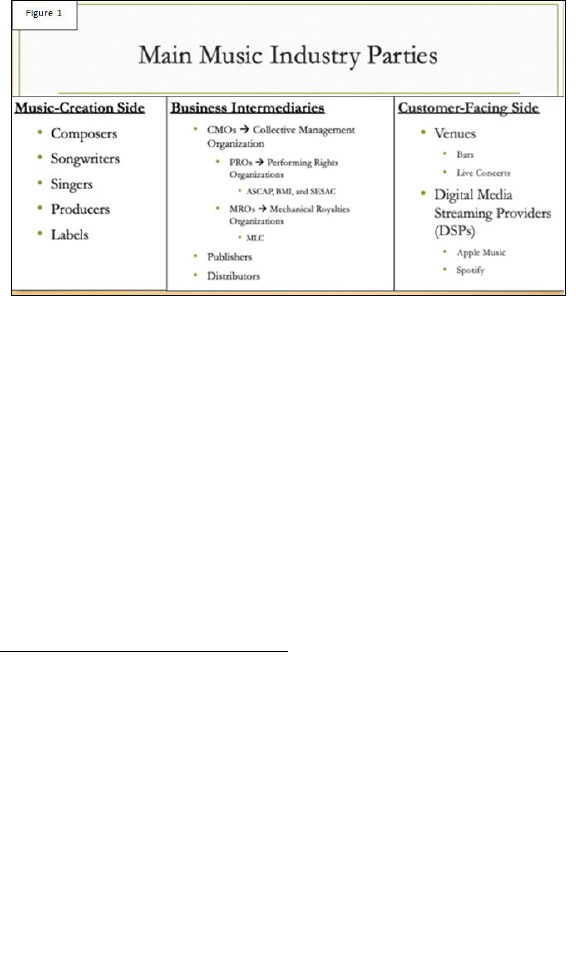
530 IDEA The Law Review of the Franklin Pierce Center for IP
63 IDEA 518 (2023)
B. Music Industry Entity Breakdown
The music industry can be grouped into the three
silos shown in Figure 1: the music-creation entities, the
business intermediaries, and the customer-facing entities.
On the music creation side, singers, songwriters, and
musicians create the composition.
31
There are also
producers, record labels, and recording artists who turn that
composition into a sound recording.
32
The business
intermediaries are distributors, streaming services,
collective rights organizations, and publishers. Distributors
are a bridge between streaming services and labels.
33
Publishers work with songwriters to register a composition
31
See id.
32
See PQ, supra note 21.
33
Distributors get music in front of the right listeners, on the
right platforms, at the right time and ensure royalties are delivered to
the copyright owners by condensing the customer-facing entity
information into manageable royalty allocation data. See Pastukhov,
Music Publishing 101, supra note 21. Distributors are a crucial part of
the recording chain with three key roles: distribute releases to DSPs,
allocate royalties appropriately, and create a marketing approach for
specific songs or clients. Id. Music distributors are now digital
infrastructure providers and rights administrators rather than just supply
chain managers. Id. They use their power as “bulk representatives” to
negotiate deals most favorable to the artists they represent. Id.

Smart Royalties: Tackling the Music Industry's Copyright
Data Discrepancies through Blockchain Technology,
Smart Contracts, and Non-Fungible Tokens 531
Volume 63 – Number 3
with a collective rights organization and use licensing fees
to make sure writers get paid.
34
Collective rights
organizations track, collect, and distribute royalties owed to
artists and creators.
35
Finally, there are customer-facing
entities. Venues generate and pay public performance
royalties for the public use of a song.
36
Streaming services
generate mechanical royalties from the streaming of a song
34
Publishers bring compositions to record labels who might
produce the work into a sound recording. Id. Music publishers can
obtain a license to use the songwriting copyright in exchange for
royalty privileges. Id. Publishers are crucial for songwriters and
producers who write songs for other artists as these individuals’ focus
is on the success of the underlying work and not the resulting sound
recording. Id.
35
Mechanical Royalty Organizations (“MROs”) collect
mechanical royalties and issue rights to anyone reproducing or
distributing copyrighted musical compositions. Music Publishing
Glossary: Mechanical Royalty Organizations (“MROs”), SONGTRUST,
https://www.songtrust.com/music-publishing-glossary/glossary-mechan
ical-rights-organization [https://perma.cc/4BTW-9FML] (last visited
Mar. 24, 2023). The Harry Fox Agency or the Mechanical Licensing
Committee (the “MLC”) established under the MMA are examples of
MROs. Performing Rights Organizations (“PROs”) license an artist’s
rights to music users, monitor the use, and collect the resulting public
performance royalties. Diana Akin Scarfo, Music Publishing 101:
What’s a Performance Rights Organization (PRO)?, REVERBNATION
BLOG (Aug. 29, 2016), https://blog.reverbnation.com/2016/08/29/music
-publishing-101-whats-a-performance-rights-organization-pro/ [https://
perma.cc/8SL5-73CK]. The three main PROs in the United States are
American Society of Composers, Authors, and Publishers (“ASCAP”),
Broadcast Music, Inc. (“BMI”), and Society of European Stage Authors
and Composers (“SESAC”). See Pastukhov, PROs, supra note 21.
PROs rely on metadata logged by DSPs, radio stations, and other
public performance venues to determine the royalty rates and payout
amounts for each artist. Id.
36
An example of a venue is a bar, restaurant, concert hall,
radio station, or other location where you hear music.

532 IDEA The Law Review of the Franklin Pierce Center for IP
63 IDEA 518 (2023)
and must distribute the collected royalties to the proper
parties.
37
III. ADDRESSING THE MUSIC INDUSTRY’S BIGGEST
BROKEN [DATA] RECORD: INCONSISTENT MUSIC
METADATA STANDARDS AND LACK OF
COMPREHENSIVE DATABASE
A. Musical Mediums—Records to CDs to
MP3s
The initial digital music data collection method had
major flaws.
38
When CDs were introduced in 1980, they
37
Streaming services, often referred to as Digital Service
Providers (“DSPs”), are entities like Apple Music or Spotify.
Frequently Asked Questions, supra note 1. While venues are just
responsible for reporting public performance royalties, DSPs must track
and distribute three different types of payments to copyright owners:
(1) mechanical royalties to the recording artist and record label from all
specific streams from a song; (2) public performance royalties paid to
the songwriter and the publisher for every public performance that
occurs; and (3) payment to recording owners such as labels or
distributors. What Music Streaming Services Pay Per Stream (And
Why It Actually Doesn’t Matter), SOUNDCHARTS BLOG (June 26, 2019),
https://soundcharts.com/blog/music-streaming-rates-payouts [https://p
erma.cc/6VAV-8UWG]. Each group is made up of many individuals.
For brevity, these groups will be referenced broadly when applicable.
38
See Ryan Waniata, The Life and Times of the Late, Great
CD, DIGITALTRENDS (Feb. 7, 2018), https://www.digitaltrends.com/
music/the-history-of-the-cds-rise-and-fall/ [https://perma.cc/FL6Y-C3J
A] (“While CDs have been on their way out for some time now, this
week’s news may as well be a eulogy or the once-mighty disc,
signaling a last step in its passing from a dominant medium to a
forgotten relic in the ever-changing pantheon of recorded music.”); see
also Anne S. Huffman, Note, What the Music Modernization Act
Missed, and Why Taylor Swift Has the Answer: Payments in Streaming
Companies’ Stock should be Dispersed Among all the Artists at the
Label, 45 IOWA J. CORP. L. 537, 538, 546–47 (2020) (recommending
that record labels and artists find contractual solutions to ensure artists
are being paid adequately for their work).

Smart Royalties: Tackling the Music Industry's Copyright
Data Discrepancies through Blockchain Technology,
Smart Contracts, and Non-Fungible Tokens 533
Volume 63 – Number 3
had minimal space to store data, so only basic song
information was tracked on the actual disk.
39
Thus, when
CDs started to be digitized into MP3 files in the late 1990s,
minimal data was available to upload.
40
Unfortunately,
there was no uniform data collection process during this
period, so dozens of databases with differing standards
resulted.
41
This lack of standardization meant that the
early-2000s digital music databases lacked key information
about the underlying rights in the songs they were
distributing. These factors built a digital universe of poorly
archived MP3 files on a foundation of inconsistent data that
continues today.
42
Despite the massive evolution of technology since
MP3 files were introduced, the incompatible metadata
standards have never been fixed. Most musical databases
still vary significantly in how they store copyright data
making the transfer between parties inefficient and
sometimes impossible. The industry is essentially playing
a game of telephone, attempting to translate data that is not
compatible from one entity to another. Inconsistent data
39
The case and lyric pamphlet that accompanied the CD
carried more specific data regarding specific publishers, recording
label, songwriters, etc. See generally Spencer Paveck, Note, All the
Bells and Whistles, but the Same Old Song and Dance: A Detailed
Critique of Title 1 of the Music Modernization Act, 19 VA. SPORTS &
ENT. L.J. 74 (2019) (discussing a detailed history of the music
industry’s adaption to the rapidly-changing digital environment); Jillian
J. Dahrooge, Note, The Real Slim Shady: How Spotify and Other Music
Streaming Services Are Taking Advantage of The Loopholes Within the
Music Modernization Act, 21 J. HIGH TECH. L. 199 (2021).
40
Waniata, supra note 38.
41
See Pastukhov, supra note 25 (“Imagine that a database
receives a value in the field ‘Back Vocalist’—when its own
corresponding column is called ‘Back Vocals.’ Algorithms won’t be
able to make that match (unless there’s a specific rule for it) and in
99% of the cases, the back vocalist’s credit will just get scraped. A big
chunk of metadata gets lost on its way through the music data chain.”).
42
Id.

534 IDEA The Law Review of the Franklin Pierce Center for IP
63 IDEA 518 (2023)
standards and the lack of a uniform database to track song
information and engagement create a substantial lag
between when a song gets played and when the creator gets
paid, typically between three months and a year depending
on the entities involved.
43
Compounding the technical translation delays is the
lack of incentive for business intermediaries to relay
collected royalties to the creators, because if the money
remains unclaimed, the default is that these entities keep
it.
44
The MMA attempted to address this disconnect by
43
Seth Lorinczi, Publishing Royalties: The Waiting Game,
SONGTRUST (Aug. 1, 2019), https://blog.songtrust.com/music-
publishing-royalties-the-waiting-game [https://perma.cc/Q2WU-WXW
J]. ASCAP has an average payout to publishers, and by extension its
artists, of 6.5 months. Id.; see supra note 35 (defining ASCAP). BMI
has an average payout of 5.5 months. How We Pay Royalties, BMI,
https://www.bmi.com/creators/royalty/general_information [https://per
ma.cc/6NBL-9JHK] (last visited Mar. 24, 2023); see supra note 35
(defining BMI). ASCAP collects metadata about work registration
such as title, writer, and/or publisher. It also uses a complex credit
system to determine how much each party receives in royalties (credits
× share × credit value = royalty). How ASCAP Calculates Royalties,
ASCAP, https://www.ascap.com/help/royalties-and-payment/payment/
royalties [https://perma.cc/4EXM-94YQ] (last visited Mar. 24, 2023);
see also Turning Performances Into Dollars, ASCAP,
https://www.ascap.com/help/royalties-and-payment/payment/dollars [ht
tps://perma.cc/QK54-39YD] (last visited Mar. 24, 2023). ASCAP
employs a census versus sample survey approach, meaning it
unintentionally discounts the artist’s actual royalty realization because
it is not economically beneficial for ASCAP to perform a census for a
certain song or genre. See The ASCAP Surveys, ASCAP,
https://www.ascap.com/help/royalties-and-payment/payment/surveys
[https://perma.cc/3QDD-HAVD] (last visited Mar. 24, 2023). As a
result, the artist will get incorrect royalties based on a sample rather
than actual plays of their work. Id.; see also Keeping Track of
Performances, ASCAP, https://www.ascap.com/help/royalties-and-
payment/payment/keepingtrack [https://perma.cc/S5JZ-62HU] (last
visited Mar. 24, 2023).
44
Chris Castle, Best Practices for Unmatched Royalties,
MUSIC TECH. POL’Y BLOG (June 24, 2014), https://musictechpolicy
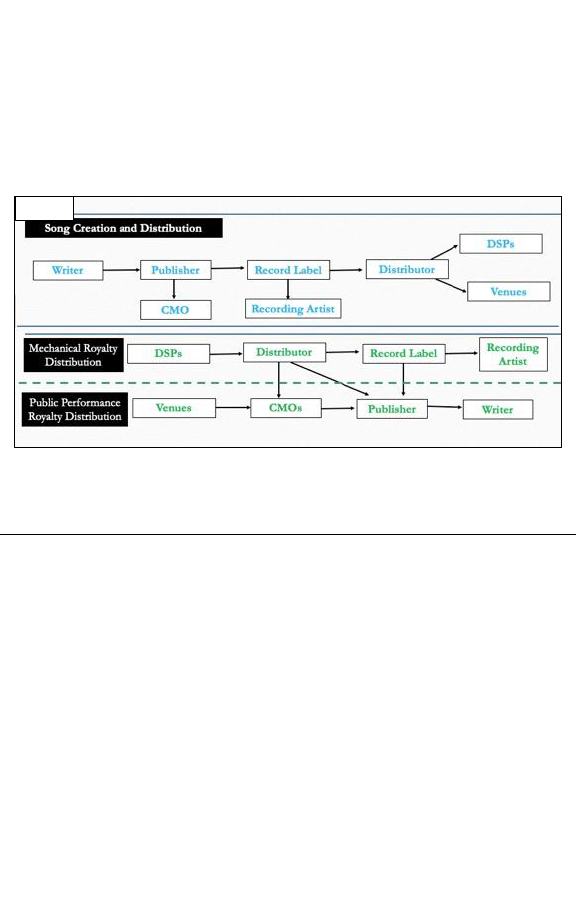
Smart Royalties: Tackling the Music Industry's Copyright
Data Discrepancies through Blockchain Technology,
Smart Contracts, and Non-Fungible Tokens 535
Volume 63 – Number 3
Figure 2
allowing streaming services to avoid some future liability if
they turned over all unpaid, unclaimed royalties that had
accrued through 2018.
45
However, under the current
system, distributors still remain an unnecessary bridge
collecting and relaying royalties between streaming
services and record labels, while publishers do the same
between the collective rights organizations and the actual
creators, as seen in Figure 2.
46
.com/2014/06/24/best-practices-for-unmatched-royalties/ [https://perma
.cc/6Z8P-687V] (“We should not be surprised that services have a great
incentive to sit on the songwriter’s money and not spend any additional
efforts to find the songwriters.”).
45
20 DSPs transferred accrued historical unmatched royalties
to the MLC. The Mechanical Licensing Collective Receives $424
Million in Historical Unmatched Royalties from Digital Service
Providers, THE MLC (Feb. 16, 2021), https://blog.themlc.com/press/
mechanical-licensing-collective-receives-424-million-historical-unmatc
hed-royalties-digital [https://perma.cc/TX6E-W9QL].
46
Since April 2016, there have been over 46 million cases
filed with the United States Copyright Office involving unidentified
songwriters. Asaf Deke, Data Has A Lot To Say About Music
Royalties, All You Need To Do Is Listen, BRIGHT DATA,
https://brightdata.com/blog/brightdata-in-practice/data-and-music-royal
ties [https://perma.cc/3BJD-CXGV] (last visited Mar. 24, 2023).

536 IDEA The Law Review of the Franklin Pierce Center for IP
63 IDEA 518 (2023)
B. Broken [Metadata] Records and Copyright
Ownership
There are two types of metadata required to create a
comprehensive music database: ownership metadata and
description metadata.
47
Ownership metadata ensures
correct royalty allocation occurs by tracking the
percentages owed to each music-creation entity involved in
a composition’s creation. Errors in this type of data are
devastating to creators as they lose both monetary
compensation and credit.
48
Descriptive metadata tracks
details about a specific sound recording.
49
Errors in this
data result in misspelled song names, mixed up release
47
Pastukhov, supra note 25.
48
Id. In fact, this type of data is often called “artist credits”
because it is a crucial way for an individual artist to gain traction and
notoriety within the industry. See id. One way to ensure artists are
protected has been the creation and implementation of songwriter split
sheets. Rory PQ, Everything You Need to Know about a Split Sheet,
ICON COLLECTIVE (May 4, 2020), https://iconcollective.edu/songwriter-
split-sheet/ [https://perma.cc/Z28U-UFX8]. The default for these
agreements is that ownership of a co-written work will be equally
divided among the contributors unless a split sheet is agreed upon. Id.
This default helps circumvent legal headache by requiring all
contributors to sit down and determine, in writing, what the ownership
split will be from the outset. Id. Without a split sheet, contributors risk
never getting paid or receiving credit for their input because PROs will
not know who to pay. Id. A split sheet must include the date, song
title, legal names of all contributing writers involved, role in the song
creation (producer, songwriter, etc.), ownership percentage for each
contributor, specific contributions (lyrics, hook, melody, beats, etc.),
record label (if applicable), PRO (if applicable), publishing company (if
applicable), mailing addresses and contact information for contributing
parties, and written signature of each contributor. Id.
49
Pastukhov, supra note 25. Description metadata collects
information about song title, release date, track number, performing
artist, cover art, and main genre. Id.

Smart Royalties: Tackling the Music Industry's Copyright
Data Discrepancies through Blockchain Technology,
Smart Contracts, and Non-Fungible Tokens 537
Volume 63 – Number 3
dates, and other inadequacies that create unmatched works
or delayed royalty distribution.
50
However, despite the 2018 enactment of the MMA
and the MLC, there has been no attempt at music data
standardization even though the MLC’s own website states
“[t]he MLC has the support of organizations from every
corner of the music industry.”
51
The MLC acknowledges
that “record companies are not required to directly deliver
their sound recording data to the MLC,” and without a
uniform system in place requiring all parties to use a
consistent standard, data discrepancies and prolonged
royalty distribution will persist.
52
If the music industry
continues to store metadata with different standards, the
difficulty in relaying information between business
intermediaries and customer-facing entities will remain
while making engagement with the information virtually
impossible for creators.
53
How can the industry implement
uniform data standards in a way that also streamlines
royalty distribution, provides more protection for creators,
and eradicates unmatched, or unclaimed works? The
answer: blockchain, smart contracts, and NFTs.
50
Id.
51
Governance and Bylaws, supra note 6.
52
Frequently Asked Questions, supra note 1.
53
The Mechanics of Music Distribution: How it Works, Types
of Music Distribution Companies + 35 Top Distributors,
SOUNDCHARTS BLOG (June 29, 2022), https://soundcharts.com/
blog/music-distribution [https://perma.cc/5BHB-LRLA]. Creators
suffer the most harm under the current system. Streaming services add
to this problem by not allowing direct music uploads, requiring creators
to engage with distributors to help get their songs heard. Id. The
reason behind the apparent lack of artist autonomy is credited to an
“unstandardized metadata and payout distribution” system making
individual artist input impossible. Id.

538 IDEA The Law Review of the Franklin Pierce Center for IP
63 IDEA 518 (2023)
IV. AN UNMATCHED SOLUTION TO THE MUSIC
INDUSTRY’S UNMATCHED ROYALTY PROBLEM:
HOW BLOCKCHAIN, SMART CONTRACTS, AND
NFTS CAN REVOLUTIONIZE ROYALTY
REGULATION AND DISTRIBUTION
A. A Universal Database with a Uniform
Standard—The MLC Blockchain
The MLC’s purpose is to ensure the public has
access and ownership over the songs that support the music
industry, but the MLC’s official website states that it “does
not have any current plans to incorporate blockchain
technology into its systems.”
54
However, while it is still in
its infancy, blockchain, smart contracts, and NFTs can
track musical metadata, aiding the MLC in ensuring that
creators get paid faster while optimizing data collection
through a uniform standard.
55
A smart digital royalty
system would also save the industry time and money by
erasing the hours of labor currently spent tackling data
discrepancies.
Data errors within the music industry are
preventable but much too common. An MLC blockchain
54
Frequently Asked Questions, supra note 1 (“Will blockchain
be used in the management of The MLC data? The MLC does not have
any current plans to incorporate blockchain technology into the
systems.”).
55
Defining Blockchain and Digital Assets, DELOITTE,
https://www2.deloitte.com/us/en/pages/about-deloitte/solutions/blockch
ain-digital-assets-definition.html [https://perma.cc/HQ8S-4MGJ] (last
visited Apr. 26, 2023) (“A non-fungible token (NFT) is a unique,
cryptographic unit of data that exists on a distributed ledger and cannot
be replicated . . . [NFTs] can represent digital media or real-world,
tangible items like artwork and real estate, which makes buying,
selling, and trading them more efficient while reducing the probability
of fraud. NFTs can also represent things like identities, property rights,
or even a bundle of rights—all encoded into digital contracts or
attestations.”).

Smart Royalties: Tackling the Music Industry's Copyright
Data Discrepancies through Blockchain Technology,
Smart Contracts, and Non-Fungible Tokens 539
Volume 63 – Number 3
would ensure musical metadata is tracked in one central
place using one uniform metadata standard.
56
Blockchains
are digital distributed ledgers that are transparent,
decentralized, and immutable.
57
Blockchains are
decentralized, so instead of storing all the information
related to a transfer within one central computer, a
blockchain network sends the information to multiple
computers across the blockchain.
58
On a decentralized
blockchain, the failure of one computer does not negatively
affect the system, because the other computers continue
56
This would create uniform standards for inputting data, filing
proofs and rollups, and approving validators to ensure accurate,
transparent data is being recorded to the blockchain. Sharding addresses
scalability issues (with so much data likely to be logged) while
decreasing environmental/economic burden on validators because it
only requires them to track and maintain certain subsets of the data on
the connecting chains, typically the root hash. Rafael Fuentes, What is
Sharding and How is it Helping Blockchain Protocols?, ROOTSTRAP
(Sept. 6, 2022), https://www.rootstrap.com/blog/what-is-sharding-and-
how-is-it-helping-blockchain-protocols/ [https://perma.cc/A5LJ-ZKW
3] (“Sharding is a process that divides the whole network of a
blockchain . . . into several smaller networks, referred to as ‘shards.’”).
ZK and optimism rollups are key to successful implementation of
sharding. Robert Stevens, What Are Rollups? ZK Rollups and
Optimistic Rollups Explained, COINDESK (Sept. 7, 2022, 10:25 AM),
https://www.coindesk.com/learn/what-are-rollups-zk-rollups-and-optim
istic-rollups-explained/ [https://perma.cc/P2S7-VAFR].
57
See Jacob Cass, 10+ Different Types of NFTs—Complete
List, JUST CREATIVE (July 26, 2022), https://justcreative.com/types-of-
nfts/#consortium-blockchains [https://perma.cc/D39R-ATW3].
Essentially, a blockchain is the digital version of printed transaction
receipts. See id.
58
What is Decentralization?, WE TEACH BLOCKCHAIN,
https://weteachblockchain.org/faq/what-is-decentralization/ [https://pe
rma.cc/GTP7-LZKT] (last visited Mar. 24, 2023); see NIAZ
CHOWDHURY, INSIDE BLOCKCHAIN, BITCOIN, AND CRYPTOCURRENCIES
13–14 (2020) (“There is no dependency on a single server; hence
blockchain does not have a central point of failure.”).

540 IDEA The Law Review of the Franklin Pierce Center for IP
63 IDEA 518 (2023)
supporting it.
59
Decentralization ensures that information
used to trace transactions can be recovered by another
computer on the blockchain if one computer fails.
60
Blockchains are transparent, because all virtual asset
transactions are recorded and accessible to anyone with
internet access. Finally, the blockchain record’s
immutability ensures all on-chain NFTs are accounted for
upon transfer.
61
There are private, public, and consortium
blockchains; the type of blockchain impacts the three
features mentioned above.
62
Public blockchains come with
more security risks because they are truly decentralized so
anyone can access them, but private blockchains are not
truly decentralized as they are only open to specific
individuals vetted by those who run that blockchain.
63
Consortium blockchains are the best of both worlds.
64
They are managed by a limited number of individuals,
called validator nodes (“nodes”), but viewable to anyone
59
See Jimi S., Blockchain: What are nodes and masternodes?,
MEDIUM (Sept. 5, 2018), https://medium.com/coinmonks/blockchain-
what-is-a-node-or-masternode-and-what-does-it-do-4d9a4200938f [htt
ps://perma.cc/26KU-RPF6].
60
See John Evans, Blockchain Nodes: An In-Depth Guide,
NODES.COM, https://nodes.com/ [https://perma.cc/RA5Q-74WW] (last
visited Mar. 24, 2023).
61
See CRYPTO DUKEDOM, THE NFT REVOLUTION: MUSIC
EDITION 20–21 (2021); see infra note 68 (discussing on-chain versus
off-chain transactions).
62
Private, public, and consortium blockchains: The
differences explained, COINTELEGRAPH, https://cointelegraph.com/
explained/private-public-and-consortium-blockchains-the-differences-e
xplained/amp [https://perma.cc/M7XY-RWV6] (last visited Mar. 24,
2023).
63
Id.
64
Id. Access to the blockchain can be as broad or as limited
as the validator nodes want. Id.

Smart Royalties: Tackling the Music Industry's Copyright
Data Discrepancies through Blockchain Technology,
Smart Contracts, and Non-Fungible Tokens 541
Volume 63 – Number 3
granted access.
65
A consortium blockchain would allow
the MLC and its Committees to oversee creation and
operation of the blockchain, while ensuring information
could only be added to the chain by private actors who had
a copyright interest in the work being logged (i.e., music
creators, publishers, record labels, and recording artists).
The main MLC blockchain, alongside four
sidechains discussed below, would track a summary of all
data from across the music industry and be governed by the
MLC and its Committees.
66
Blockchains often have
oracles—entities that transfer real-world data onto the
blockchain—and the MLC itself would be the main oracle
in this system.
67
It would screen music-creation entities,
65
See Jimi S., supra note 59. Validator nodes are authorities
on the blockchain that can submit data for consideration to be entered
on the chain. Id.; see CHOWDHURY, supra note 58, at 18 (“A
fundamental problem in distributed systems is achieving overall system
reliability in the presence of some faulty nodes . . . . Blockchain being a
distributed system requires its nodes to reach a consensus while
running the system and keeping its data secure.”).
66
See Governance and Bylaws, supra note 6; see also supra
notes 8–12 and accompanying text (discussing advisory committees).
67
See What is a blockchain oracle, and how does it work?,
COINTELEGRAPH, https://cointelegraph.com/blockchain-for-beginners/
what-is-a-blockchain-oracle-and-how-does-it-work [https://perma.cc/D
S3Y-XP3N] (last visited Mar. 24, 2023). While Proof of Work and
Proof of Stake are the most common blockchain consensus methods,
the blockchain argued for in this paper would use a Proof of Authority
(“PoA”) consensus method. Simon Chandler, Proof of stake vs. proof
of work: key differences between these methods of verifying
cryptocurrency transactions, BUS. INSIDER (Nov. 21, 2022, 1:12 PM),
https://www.businessinsider.com/personal-finance/proof-of-stake-vs-
proof-of-work [https://perma.cc/FH27-GEUQ]; see also Proof-of-
authority vs. proof-of-stake: Key differences explained,
COINTELEGRAPH [hereinafter Proof-of-authority], https://cointelegraph.
com/blockchain-for-beginners/proof-of-authority-vs-proof-of-stake-key
-differences-explained [https://perma.cc/4BBP-ZU2B] (last visited
Mar. 24, 2023) (“The PoA consensus process grants a few . . . players
the authority to validate network transactions and update [the

542 IDEA The Law Review of the Franklin Pierce Center for IP
63 IDEA 518 (2023)
business intermediaries, and customer-facing entities who
apply to operate nodes in the system and ensure all parties
are using a uniform data standard when relaying
information to the main chain.
68
Additionally, there would
be four sidechains: (1) a chain run by publishers, creators,
and collective rights organization nodes to log music
composition data (“Composition sidechain”); (2) a chain run
by record labels, recording artists, and distributor nodes to
log sound recording data (“Sound Recording sidechain”);
(3) a chain focused on tracking mechanical royalty
chain] . . . . The PoA consensus differs from the [Proof of Stake] in that
it uses identity rather than the digital assets . . . . Thus, a person’s
reputation is more valuable than their possessions . . . . Validators are
pre-approved by a group of “authorities” to verify transactions and
build new blocks. To be trusted, validators must adhere to a set of
requirements.”). PoA would also help create censorship-resistant
records. William M. Peaster, A Beginner’s Guide to ETH Validators,
BANKLESS (Sept. 20, 2022), https://newsletter.banklesshq.com/p/a-
beginners-guide-to-eth-validators [https://perma.cc/7CAK-Q2N9].
68
There are two types of blockchain transactions: on-chain
transactions and off-chain transactions. See Rohan Pinto, On-Chain
Versus Off-Chain: The Perpetual Blockchain Governance Debate,
FORBES (Sept. 6, 2019, 8:00 AM), https://www.forbes.com/sites/forbes
techcouncil/2019/09/06/on-chain-versus-off-chain-the-perpetual-blockc
hain-governance-debate/?sh=525fc1a61f5e [https://perma.cc/DUT3-
DZEA]; see also William M. Peaster, NFTs and the On-Chain
Spectrum, BANKLESS (Feb. 4, 2021), https://metaversal.banklesshq
.com/p/nfts-and-the-on-chain-spectrum [https://perma.cc/W3RH-FUR
J]. On-chain transactions are much more secure, but they take up more
space on the system, increase the power needed to add a new block to
the chain, and cost a lot more. See Jake Frankenfield, On Chain
Transactions (Cryptocurrency), INVESTOPEDIA (Aug. 24, 2021),
https://www.investopedia.com/terms/c/chain-transactions-cryptocurren
cy.asp [https://perma.cc/HTJ6-4ZW7]. Off-chain transactions are the
simpler, cheaper way to get something logged on the blockchain, but
they are much less secure. See Amanda J. Sharp, Note, Head in the
BitCloud: A Discussion on the Copyrightability and Ownership Rights
in Digital Art and Non-Fungible Tokens, 59 SAN DIEGO L. REV. 637,
651–52 (2022) (discussing the key differences between these
transaction types).
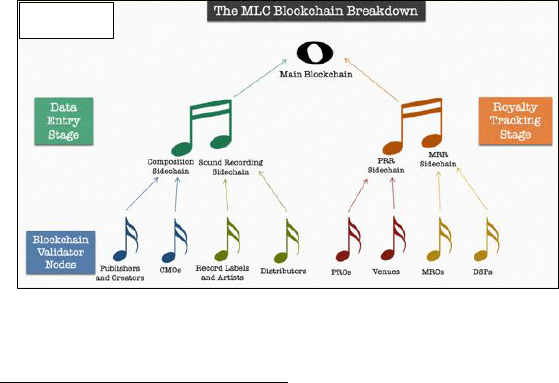
Smart Royalties: Tackling the Music Industry's Copyright
Data Discrepancies through Blockchain Technology,
Smart Contracts, and Non-Fungible Tokens 543
Volume 63 – Number 3
accumulation (“MRR sidechain”); and (4) a chain focused
on tracking public performance royalty accumulation (“PRR
sidechain”). Sidechains are compatible independent
blockchains that supply information to the main chain, often
via rollups.
69
Blockchain rollups condense a sidechain’s
most important information into a data summary that gets
posted on the main chain for future reference and tracking
purposes.
70
The sidechain nodes inputting song ownership
data would be run by approved music-creation and business
intermediaries, while the sidechain nodes tasked with
collection of royalty distribution data would be run by
approved business intermediaries and customer-facing
nodes.
69
See Fuentes, supra note 56. Sidechains allow smart
contracts to be created within their chain and then deployed and tracked
on the main chain by using a universal base layer code. See Execution
Layer (EL) and Consensus Layer (CL) Node Clients (2022), ALCHEMY
(July 8, 2022), https://www.alchemy.com/overviews/execution-layer-
and-consensus-layer-node-clients [https://perma.cc/XUT8-7XFV].
70
See Fuentes, supra note 56; Stevens, supra note 56.
Figure 3

544 IDEA The Law Review of the Franklin Pierce Center for IP
63 IDEA 518 (2023)
As Figure 3 shows, each sidechain would play a
crucial role in the data tracking and distribution process.
The Composition sidechain would ensure that creators and
publishers are accounted for and eradicate unclaimed works.
The Sound Recording sidechain would ensure that record
labels, recording artists, and distributors are compensated
and eliminate unmatched works. The MRR sidechain
would verify correct mechanical royalty data is processed,
while the PRR sidechain would track venue logs and
guarantee accurate public performance royalties are
distributed.
71
Blockchains eradicate data errors by employing
consensus mechanisms.
72
Consensus mechanisms require
at least fifty-one percent of a chain’s nodes to validate the
information before it can be recorded on the blockchain.
73
Within the MLC blockchain, the consensus threshold will
incentivize entities to log accurate data. Each of the four
71
The MLC blockchain would function on a Proof of Authority
consensus model that allows for the input of data, execution of data
validation mechanisms, and approval of validator nodes to run the side
and subchains. See Proof-of-authority, supra note 67 for a discussion
on blockchain consensus methods and Proof of Authority.
72
Employing an intermediary in the contracting process
increases the cost and slows down the processing time putting an
unfair, and unnecessary, burden on the artist. Smart Contracts and
Financial Services, DELTEC BANK (Feb. 15, 2022),
https://www.deltecbank.com/2022/02/15/smart-contracts-and-financial-
services/ [https://perma.cc/9J4R-5PWS]. Intermediaries are not
autonomous or decentralized, so they can easily take advantage of less
experienced or novice parties, but smart contracts do not need
intermediaries to verify their transactions and are reusable which
speeds up the process of logging information in the databases that
eventually determine what royalties each party is owed. See id.
73
This can work in the reverse via something referred to as a
51% attack. 51% Attack: Definition, Who Is At Risk, Example, and
Cost, INVESTOPEDIA, https://www.investopedia.com/terms/1/51-attack
.asp [https://perma.cc/9WUZ-X3E8] (last visited Apr. 24, 2023)
(“Owning 51% of the nodes on the network gives the controlling
parties the power to alter the blockchain.”).

Smart Royalties: Tackling the Music Industry's Copyright
Data Discrepancies through Blockchain Technology,
Smart Contracts, and Non-Fungible Tokens 545
Volume 63 – Number 3
sidechains’ nodes would then take the information, confirm
it is correct by reaching a consensus across the chain, and
roll the data up so it can be logged on the main MLC
blockchain.
To ensure all parties remain invested in the
blockchain’s mission and incentivize accurate, timely
reporting, the MLC should require business intermediaries
and customer-facing entities to stake (i.e., provide for a set
time) a portion of their profits on the chain. Staking is like
placing money in a high-yield savings account—the staking
nodes contribute money to a fund that is used to help run
the blockchain and maintain its security.
74
While staking
has traditionally been done to incentivize investment and
participation in the block verification process, in the MLC
blockchain it would act as both an incentive and deterrent.
75
The staked profits would be returned to the entities on a
rolling basis. Nodes that consistently attempt to log
inaccurate data will be warned, suspended, or permanently
banned from partaking in future reporting.
Staking helps align the parties’ interests by ensuring
nodes are rewarded when the system performs successfully
and incentivizes all entities to work towards faster, fairer
royalty distributions. Additionally, the MLC could ensure
music-creation entities participate in good faith by making
future ownership dispute claims contingent on a showing
that reasonable effort was taken by the music-creation
individuals to input correct ownership data when first
registering the work. This would incentivize music-creation
74
Krisztian Sandor, Crypto Staking 101: What is Staking?,
COINDESK (Nov. 22, 2022, 9:43 AM), https://www.coindesk.com/
learn/crypto-staking-101-what-is-staking/ [https://perma.cc/67SH-JLG
P].
75
Ethereum 2.0 Staking: A Beginner’s Guide on How to Stake
ETH, COINTELEGRAPH, https://cointelegraph.com/ethereum-for-begin
ners/ethereum-2-0-staking-a-beginners-guide-on-how-to-stake-eth [http
s://perma.cc/8RGT-LJ4W] (last visited Mar. 24, 2023).

546 IDEA The Law Review of the Franklin Pierce Center for IP
63 IDEA 518 (2023)
entities to contribute comprehensive composition and sound
recording data on the sidechains or risk losing the chance to
dispute inaccuracies later.
Once the initial blockchain is created and the nodes
are in place, the actual data collection and royalty
distribution should be self-executing.
76
No additional
administrative agency needs to be created to handle
disputes arising in connection with this technology as any
legal causes of action could be handled under the same
resolution avenues available to ordinary legal claims.
77
In
fact, not only could this solution revolutionize the way the
United States handles music royalty distribution, but
blockchain’s digital aspect could eventually allow for
global participation in data collection, which could one day
lead to the unification of the entire music copyright system.
The problems facing the music industry are international,
and by implementing blockchain, information can be
contributed from international entities, artists would have
better global protection against copyright infringement, and
fast, fair royalty payments could become a universal reality.
Employing blockchain technology verifies that
accurate information is logged in a universally accessible
database and creates uniformity by requiring all entities to
engage with identical, complete data sets. The
blockchain’s transparency allows all parties to access real-
time royalty information. The MMA laid the groundwork
for streamlined royalty regulation and distribution;
blockchain can take those ideas and make them tangible
solutions.
76
See infra Section IV.B.
77
For example, contract term interpretations, bad actors,
copyright infringement, etc.

Smart Royalties: Tackling the Music Industry's Copyright
Data Discrepancies through Blockchain Technology,
Smart Contracts, and Non-Fungible Tokens 547
Volume 63 – Number 3
B. Consistent, Automatic Royalty
Distribution—Smart Contracts
Historically, traditional contracts have solidified the
terms negotiated between parties, but they can create
discrepancies through nuanced interpretations and data
errors.
78
Traditional contracts also require parties to sign
separate documents and pay separate fees to complete a
transaction.
79
Smart contracts can tackle both inaccuracies
and inefficiencies. Smart contracts are neither smart nor
contracts; rather, they are computer codes that aid the
blockchain in recording transactions accurately by
automatically executing terms set in a multiparty
agreement.
80
“Smart contracts are tamper-resistant, self-
78
Paul Resnikoff, Welcome to the ‘Royalty Black Box,’ the
Music Industry’s $2.5 Billion Underground Economy, DIGITAL MUSIC
NEWS (Aug. 3, 2017), https://www.digitalmusicnews.com/2017/08/
03/music-industry-royalty-black-box/ [https://perma.cc/K6CH-3Y9C].
Additionally, most administrative issues occur because humans
accidentally misreport or inaccurately input data. The music “royalty
black box” is a $2.5 billion economy where unclaimed, unmatched,
delayed, and other types of unpaid streaming royalties live. Id.; see
also Unmatched Royalties, FAIR TRADE MUSIC INT’L,
https://www.fairtrademusicinternational.org/campaigns/unmatched-roy
alties/ [https://perma.cc/TC4T-83NE] (last visited Mar. 25, 2023).
79
See John Ream et al., Upgrading Blockchains: Smart
Contract Use Cases in Industry, DELOITTE (June 8, 2016),
https://www2.deloitte.com/us/en/insights/focus/signals-for-strategists/
using-blockchain-for-smart-contracts.html [https://perma.cc/MTN5-
FBFW].
80
Id. Blockchain revolutionized the application of smart
contracts by creating a shared database that runs on a decentralized
protocol allowing both parties to validate the transaction
instantaneously and facilitating the auto-execution of the smart contract
code without the input of a third-party intermediary. Id. The term
smart contract was first coined in 1996 by well-known cryptographer
Nick Szabo. Samuel Mbaki Wanjiku, Nick Szabo—Who Is He and
What Is His Influence on Modern Cryptocurrencies?, CRYPTO.NEWS
(Apr. 14, 2022), https://crypto.news/nick-szabo-who-is-he-and-what-is-
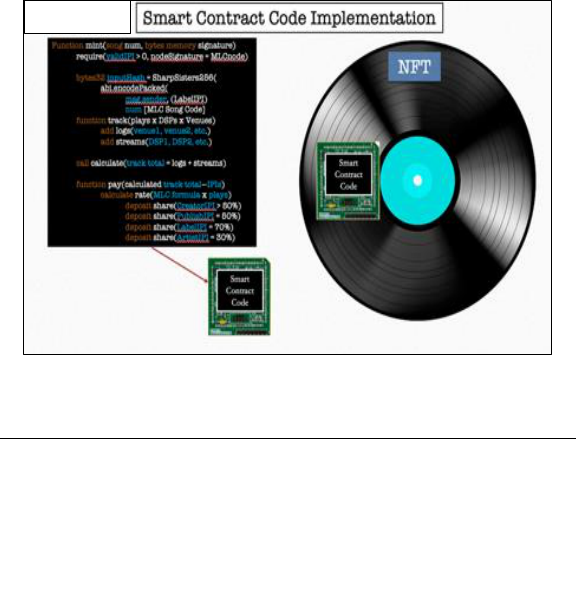
548 IDEA The Law Review of the Franklin Pierce Center for IP
63 IDEA 518 (2023)
executing, and self-verifying.”
81
They decrease lag time
between transactions—as they execute functions
instantaneously upon command—and can carry out
unlimited functions in one single transaction making
separate fees and documents unnecessary.
82
The automated
nature of smart contracts makes them quick, and since they
require no intermediaries to execute transactions, they
ensure transparency between parties by assuming the
burden of transaction validator and executor.
83
his-influence-on-modern-cryptocurrencies/ [https://perma.cc/9FMZ-44
97].
81
Smart Contracts and Financial Services, supra note 72.
82
See id.
83
Id. (“[T]he smart contracts auto-execute [and] . . . validate
the outcome instantaneously and without need for a third-party
intermediary.”). The smart contracts used on the MLC blockchain
would be written in the BWARM Code—a code implementation created
by the MLC and its partners. Bulk Database Feed, THE MLC,
https://www.themlc.com/bulk-database-feed [https://perma.cc/8KWN-
FJTE] (last visited Mar. 25, 2023).
Figure 4

Smart Royalties: Tackling the Music Industry's Copyright
Data Discrepancies through Blockchain Technology,
Smart Contracts, and Non-Fungible Tokens 549
Volume 63 – Number 3
C. Music Mediums Revisited—CDs to MP3s
to NFTs
To really improve the music royalty system, smart
contracts and blockchain technology must work in tandem
to provide real-time, accurate royalty distribution. If
creators are the most valuable aspects of the music
industry, NFTs are their web3 equivalent.
84
NFTs are
unique and cannot be replicated.
85
While the word token
might suggest NFTs are associated with a physical coin,
NFTs are simply unique data strings that provide public
proof of asset ownership.
86
Similar to how a barcode on an
item of clothing marks the clothing’s price, tracks
inventory of that item, and can be referenced to verify that
an authentic purchase has occurred, NFTs can track digital
84
See generally Matthieu Nadini et al., Mapping the NFT
Revolution: Market Trends, Trade Networks and Visual Features, 11
SCI. REPS. 9 (2021); see also Aaron Mak, What Is Web3 and Why Are
All the Crypto People Suddenly Talking About It?, SLATE (Nov. 9,
2021, 5:45 AM), https://slate.com/technology/2021/11/web3-explained
-crypto-nfts-bored-apes.html [https://perma.cc/FEL4-36AG]; see also
Moxie Marlinspike, My First Impressions of Web3, MOXIE (Jan. 7,
2022), https://moxie.org/2022/01/07/web3-first-impressions.html [https
://perma.cc/S9U9-E2PB]; see also Luis Gallardo, Web3—Community,
Ownership, Decentralization, Utility, WORLD HAPPINESS FOUND. (Apr.
13, 2022), https://worldhappiness.foundation/blog/happiness/web3-
community-ownership-decentralization-utility/ [https://perma.cc/SH6B
-8G8B].
85
See Jacob Cass, What is an NFT? Starter Guide for
Designers, Artists & Creatives, JUST CREATIVE (Aug. 25, 2022),
https://justcreative.com/what-is-an-nft/ [https://perma.cc/GC62-XLC
M].
86
See Georgina Adam, But is it Legal? The Baffling World of
NFT Copyright and Ownership Issues, THE ART NEWSPAPER (Apr. 6,
2021), https://www.theartnewspaper.com/2021/04/06/but-is-it-legal-the
-baffling-world-of-nft-copyright-and-ownership-issues [https://perma.c
c/R5T5-RFRG] (“An NFT is just a link to a work of art stored on
another platform . . . .”).

550 IDEA The Law Review of the Franklin Pierce Center for IP
63 IDEA 518 (2023)
asset ownership and verify a transaction’s authenticity.
87
NFTs are commonly used to track the sale of digital
artwork but can be used to track other copyrighted works.
88
NFTs are the vehicle that will accomplish the
MLC’s goal of uniform data tracking and streamlined
royalty distribution.
89
When a composition is created, the
music-creator entities would enter copyright information
into an MLC template that would generate a smart contract
programmed to execute that composition’s particular
royalty distribution functions.
90
That composition’s smart
contract would then be (1) recorded on the Composition
sidechain; (2) deployed each time a corresponding sound
recording is produced; and (3) included in a Composition
sidechain roll-up logged on the main blockchain. Then,
when a record label records a song using that underlying
composition, its sound recording metadata will be
automatically matched to the composition smart contract,
87
Cass, supra note 57.
88
See generally Sharp, supra note 68, for an in-depth
discussion on common NFT uses. ISWC codes, ISRC codes, IPI
numbers, Songwriter Split Sheets, etc. are all captured and recorded in
the NFT metadata. See supra notes 24, 25, 48, and infra note 92 for
detailed descriptions of each. The smart contracts within the NFTs
would track the length of time the song was played, the number of
engagements with that song from a particular streaming service during
a specific period, etc. The fair-use exception is outside the scope of
this paper, but the MLC and its committees would likely create some
sort of time limit that would qualify as de minimis use. For example, if
a song only played for 15 seconds or less, no royalties would accrue,
and no customer-facing entities would be charged.
89
See Chelsea Cohen, Note, Welcome to Web 3.0: A
Reevaluation of Music Licensing and Consumption to Level the
Payment Imbalance for Songwriters, 45 HASTINGS COMM. & ENT. L.J.
45, 73 (2023).
90
See David Idokogi, Note, Decentralizing Creativity: A
Tenable Case for Blockchain Adoption in the Entertainment Industry,
47 RUTGERS COMPUT. & TECH. L.J. 274, 293 (2021) (discussing how a
smart contract could calculate and streamline the distribution of fees
and royalties owed to all parties).

Smart Royalties: Tackling the Music Industry's Copyright
Data Discrepancies through Blockchain Technology,
Smart Contracts, and Non-Fungible Tokens 551
Volume 63 – Number 3
the sound recording royalty splits will be added to the smart
contract, and the completed song would be minted as an
NFT on the Sound Recording sidechain and added to the
main blockchain. The data logged on the sidechains would
be incorporated into the NFT tying the ownership and
descriptive metadata back to the creators themselves
through unique blockchain aspects like digital addresses and
wallets.
91
Incorporating digital addresses and wallets
directly into the song’s metadata would allow the artist and
creators to be paid simultaneously with the publishers and
record labels. Each NFT would also house a smart contract
function to track engagement with each song and ensure the
royalty allocations were recorded and accessible for future
reference.
The smart contract within the NFT could distribute
earned royalties automatically and ensure compensation is
transferred to the right individuals by matching ownership
information with royalty distribution percentages.
92
Eventually, music catalogs would contain only scannable
91
Each creator’s IPI number would be linked to a digital
wallet and address to streamline royalties. See infra note 92 for a
discussion on IPI numbers. A digital address is basically a more secure
version of a social media username—it links to a user’s transaction
history, cryptocurrency balance, and NFT image collection. See Sharp,
supra note 68, at 640. A digital wallet attaches to a digital address and
acts as a storage facility for all NFTs and other digital assets attributed
to that address. Id.; see also Henrique Centieiro, All you need to know:
NFT Wallets—Custodial vs. Non-Custodial, LEVEL UP CODING (Sept.
30, 2021), https://levelup.gitconnected.com/all-you-need-to-know-nft-
wallets-custodial-vs-non-custodial-e4bdb0c50889 [https://perma.cc/Y
8BH-UH5L]. See Best NFT Wallets for 2022, ASCENT (Aug. 1, 2022),
https://www.fool.com/investing/stock-market/market-sectors/financials
/non-fungible-tokens/nft-wallet/ [https://perma.cc/T72N-LB3V], to
learn more about the different digital wallets available.
92
Interested Party Information codes (“IPI number”) are artist-
specific tracking numbers given to songwriters, composers, and
publishers. All About IPI Numbers, ASCAP, https://www.ascap.com/
help/registering-your-music/ipi-faqs [https://perma.cc/V59Y-HYAT]
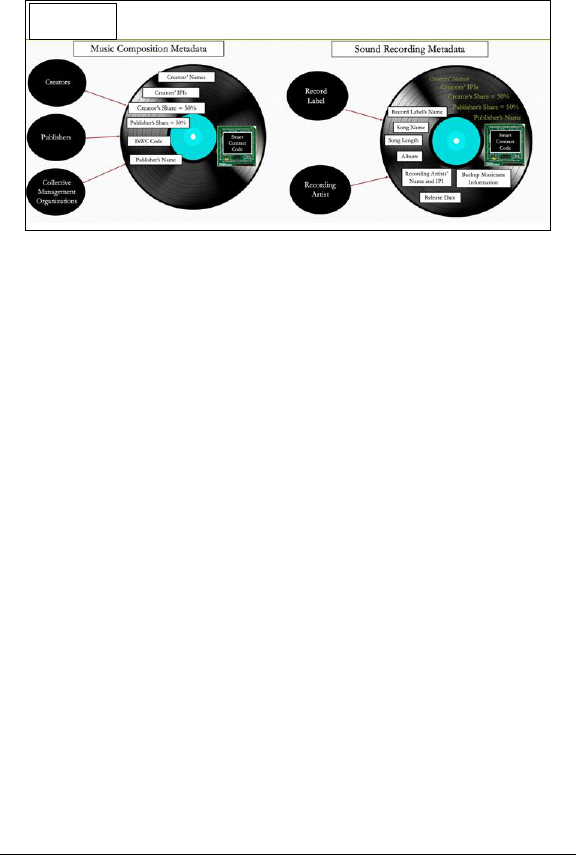
552 IDEA The Law Review of the Franklin Pierce Center for IP
63 IDEA 518 (2023)
NFTs that link to the sound recording, musical
composition, and the royalty allocation splits. Any
customer-facing engagement (i.e., playing the song) would
trigger the smart contract to record the use, retain the proper
funds from the customer-facing party, and distribute the
earned royalties to the proper digital wallets linked to the
creators via the metadata within the NFT. Embedding smart
contracts in the NFTs would eliminate the problems
inconsistent data standards create. Linking each song’s
ownership metadata—regarding what parties owe money
and what parties receive money—to a creator’s digital
address and wallet enables instantaneous royalty
distribution. This revolutionizes the royalty distribution
process.
V. CONCLUSION
Despite decades of music digitization, the system is
still flawed, suffering from delays, and depriving creators
of earned royalties and important recognition. Employing
blockchain technology, smart contracts, and NFTs can help
(last visited Mar. 25, 2023). The IPI number could be attached to a
creator’s digital address or wallet to streamline metaverse and real-
world cohesion while also ensuring that the anonymity created via
digital addresses does not negatively impact this blockchain. See supra
note 91 for a discussion on digital addresses and digital wallets.
Figure 5
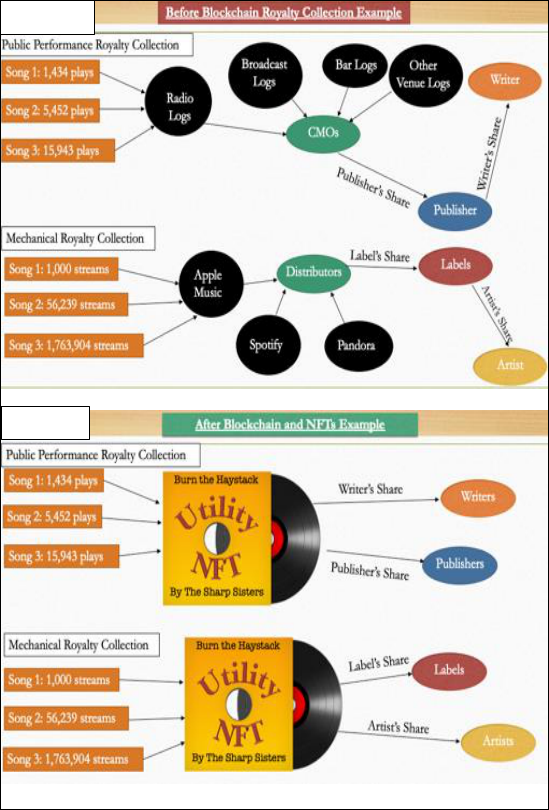
Smart Royalties: Tackling the Music Industry's Copyright
Data Discrepancies through Blockchain Technology,
Smart Contracts, and Non-Fungible Tokens 553
Volume 63 – Number 3
the MLC honor its purpose and mend the broken
[metadata] record that has plagued an industry dependent
on transparency, collaboration, and innovation.
Figure 6
Figure 7
554 IDEA The Law Review of the Franklin Pierce Center for IP
63 IDEA 518 (2023)
The MLC’s blockchain would be a database
monitored by music-creation entities, business
intermediaries, and customer-facing entities acting as node
operators. A uniform data entry process would ensure
contributors get credit, while uploading this information to
a central blockchain would create a record of each sound
recording and musical composition’s ownership data.
Smart contracts would streamline royalty distribution for
creatives, while connecting songs to NFTs would eradicate
future unmatched or unclaimed works.
A customer enters a bakery and orders a chocolate
chip cookie. The customer scans a card and the cookie’s
price is automatically deducted from their bank account and
transferred to the baker. The cookie sale is logged in the
bakery’s inventory to track sales and demand for future
orders. The baker is paid for their efforts. The customer
eats the cookie. There is a digital log of the transaction,
from creation to consumption, and no discrepancy exists.
Efficient markets already require these standards for
exchanges of goods and services. Now, the MLC must
adopt these principles and make three key changes: (1)
create a blockchain with a uniform data standard to replace
the current inconsistent databases; (2) use smart contracts
for autonomous royalty distribution; and (3) implement
NFTs to track and connect the smart contracts to the
blockchain. When this is done, the vast problems that
prolonged music royalty distribution has historically
created will be eradicated, and the broken metadata record
that has played on repeat for decades will finally be fixed.
